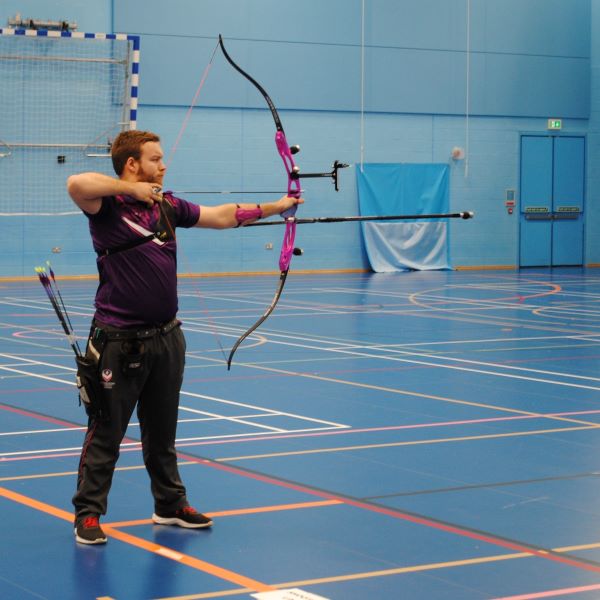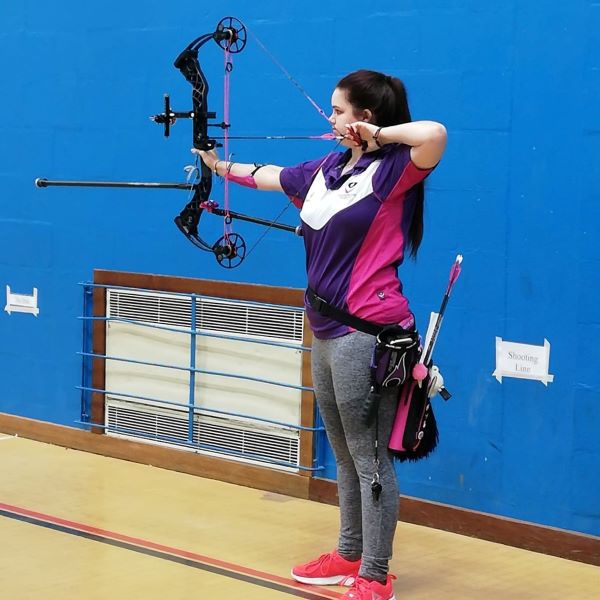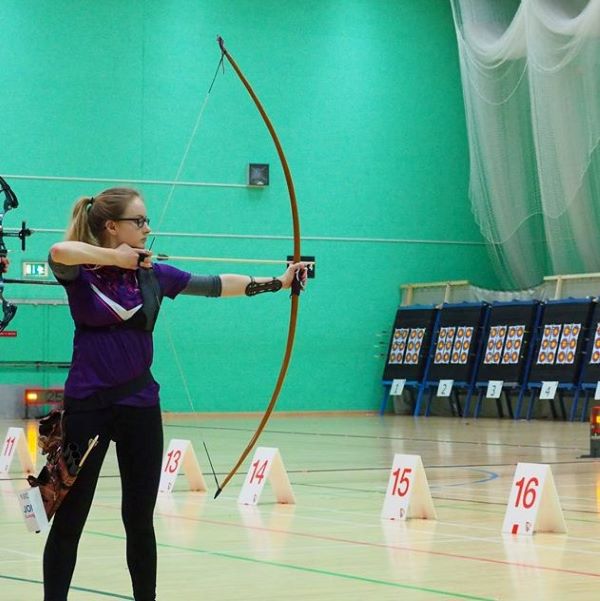Equipment
We don't reccomend that novices buy their first bow too soon. Finish the beginners course, maybe have a play with the various different bow styles, and decide what you want to shoot. The earliest we reccomend people buying bows is around Chrismas, once you've been shooting for a couple of months.
Other items, such as tabs, armguards, quivers, etc. should be purchased reasonably soon (within the first few weeks). These items are relatively inexpensive and it's a good idea to have your own from an early stage.
Here is a detailed Equipment Buying Guide, aimed at helping novices select a suitable set up for their first recurve bow, if you have any further questions speak to the club coaches or experienced archers.
Tuning
Tuning is the process by which the bow is set up in such a way that is is shooting optimally. Basic tuning (such as nocking point, brace height, button tension, etc.) should be performed as soon as you get your own kit. For those who are interested in learning how to tune their bow, the How to Tune guide should tell you everything you ever needed to know. If you are unsure about anything, ask a coach or experienced archer to help you.
Bow Types
In archery there are various different styles of bow which can be used. In competitions, archers will only compete against others using the same style of bow, meaning archers using the latest compound bows will not be shooting against those using medieval longbows.
Recurve

The recurve, as used in the Olympics, is the most popular type of bow in the UK and the type we train novices to use. They are made up of three main parts: the “riser” (handle) and two “limbs” which slot or screw into the riser. The riser can be made of wood, metal, or carbon and the limbs can be wood, fiberglass, carbon fiber, or foam — often a combination of materials are used to make the limbs fast and smooth to draw.
Normally, a “sight” will be attached to the riser to help with aiming. Stabilisers, usually consisting of a “long rod” and “v-bars” may also be fitted to the bow to help the balance and make it more stable while aiming. Longrods and short rode may be fitted with rubber devices at the ends which help to remove vibration after the shot.
A recurve without a sight or stabilisers is known as a “barebow”. Most archers will learn barebow for the first couple of beginner's sessions before we introduce archers to sights

Compound
Invented in the United States in the 1960's, the compound is the most technically advanced form of bow. Compound bows have much stiffer limbs than recurves so a levering system of cables and pulleys is necessary to make them bend. They are typically more powerful and accurate than recurves and, when fully drawn back, require less strength to hold than a recurve with a similar draw weight.
Like recurve bows, compounds are usually fitted with with a stabilisation system. Compound archers are also allowed to use some extra bits, like telescopic sights and mechanical release aids, which are used instead of drawing the string with the fingers. However, like recurves, compounds can also be shot without sights and stabilisers if desired.
Longbow

Used for hunting for thousands of years, and also popular as a weapon of war since the middle ages, longbow archery became popular as a sport in Victorian times. Longbows are roughly the same height as the archer and can be made of a single piece of wood (called a self bow) or, more commonly, several different types of wood glued together.
Being traditional bows, they do not have sights, arrow rests or any other bits and pieces used with recurves and compounds. However, longbow archers are allowed to use an elastic band on the limb of the bow, or a marker on the floor as a reference point to assist with aiming.
Other Equipment
As well as bows there are various other pieces of equipment which are essential and are detailed below. There is also a guide aimed at novices looking at buying their first set of kit.
Arrows
Arrows are made up of 4 main parts: the point, shaft, fletches and nock. The point of the arrow is normally made from stainless steel and is often available in various different weights to allow the archer to fine tune the bow. The shaft of the arrow will be made from aluminium, carbon, or a composite of the two. Aluminum arrows are generally cheaper and more suitable for beginners. Traditional arrows are made from wooden shafts.
The fletches can be made plastic or feather and are used to stabilise the arrow during flight. The nock is the groove at the opposite end of the arrow to the point, it is used to attach the arrow to the string.
Arm Guard and Tab
Arm guards (or bracers as they're sometimes called) are there to protect your arm from the string of the bow after you release it. Some experienced archers choose not to use an arm guard as they have learned to hold the bow so the string doesn't hit them. However, even the most experienced archers can make a slight mistake occasionally, which usually leads to a rather uncomfortable bruise.
The tab is what stops the string from hurting your fingers when you draw the string back. Tabs are usually made of leather (or similar synthetic material). Some tabs have a platform attached to them for you to put under your chin, so you know when you have drawn the string back the correct distance.
Quiver
Quivers are what you put your arrows in so you don't have to keep picking them up off the floor. Once you become more involved in archery you may start to keep other things in your quiver such as scorepads, pens, arrow pullers, confectionary of some type, and such like. Some people also like to use them to shamelessly parade the medals they have won in various competitions!
Finger/Wrist Sling
You may or may not know that you are not meant to hold on to the bow during the shot. The reason for this is that if you grip the bow as the arrow leaves the string, you can twist the bow and affect the arrow’s flight. However, if you attempt to not grasp the bow without first attaching the bow to your hand in some way, you are going to drop it. Slings are usually attached to either the fingers or wrist and are looped around the bow to stop you from dropping it after you release.
